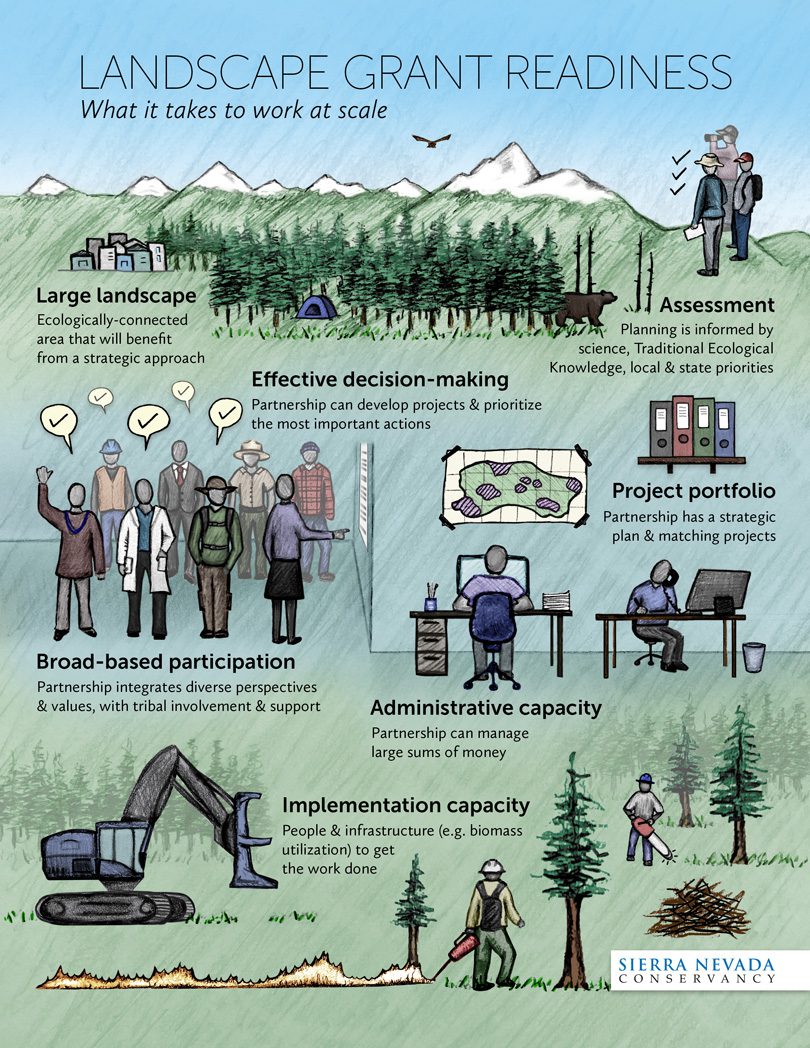In recent years, the conversation in California has shifted from whether to invest heavily in climate and wildfire resilience to how to most effectively invest and deploy resources across large, forested landscapes. Working at the scale of modern megafires and disturbances, across tens of thousands of acres, depends on a strong network of partners that are ready for significant, long-term investment. This concept of “readiness” is at the heart of the Sierra Nevada Conservancy’s (SNC) Landscape Investment Strategy.

Landscape grants, or block grants to restore an entire large landscape, present critical opportunities to accelerate the state’s Wildfire and Forest Resilience Action Plan in California’s Sierra-Cascade region. Designed in partnership with SNC’s local, regional, state, and federal partners, the Landscape Investment Strategy calls for large block grants to forest partnerships to complement SNC’s existing Watershed Improvement Program (WIP) activities.
Forest partnership capacity key to landscape grant readiness
Effective forest partnerships—the place-based, multi-interest, multi-jurisdictional groups that develop and implement restoration projects—are essential to working at the landscape scale.
Key attributes of a “ready” partnership reflect a capacity to develop, plan, and implement a strategic program of restoration across a landscape, and include:
- Broad-based participation ensures that the partnership incorporates a range of interests, values, and expertise, creating better and more equitable outcomes, building public support for the work, and reducing the chances of significant opposition.
- Effective decision-making enables a partnership to navigate the dynamics of large-scale, multi-interest projects and adapt to changing conditions and opportunities.
- A shared and defined landscape of interest that is ecologically connected and will benefit from a strategic approach to restoration.
- An assessment of landscape conditions, values, and vulnerabilities enables a partnership to develop a restoration plan that aligns with local and state priorities.
- A portfolio of projects, including some that are shovel-ready, provides confidence that work will be able to begin promptly and continue throughout the duration of the landscape grant.
- High-administrative capacity ensures that both funding and restoration will be competently managed and implemented with public accountability.
- Access to implementation capacity, including the workforce for restoration treatments and the infrastructure to process residual woody biomass, ensures that work on the ground can proceed apace.
Building the readiness pipeline
A number of Sierra-Cascade partnerships are ready for grants supporting landscape-scale restoration. As part of its Landscape Investment Strategy, the SNC anticipates directing a pilot grant award to a forest partnership this summer. Others need more time and support to reach the “readiness” point.
This is where SNC capacity-building initiatives, like the Regional Forest and Fire Capacity Program in the Sierra-Cascade, come in. By investing in collaborative planning and capacity-building efforts, SNC is working to ensure that, over time, all partnerships in our region are moving along the path toward landscape grant “readiness.”
Even so, reaching our broader climate-resilience goals requires sustained investment at various scales. Landscape grants should supplement the investments the SNC and other funders will continue to make in important, smaller-scale projects. Protecting a rural hospital or a grove of giant sequoia is important whether or not it is part of a comprehensive landscape strategy.
Ultimately, empowering “ready” forest partnerships with the resources to be good stewards of the landscapes where they live, work, and play is how California can create a more resilient Sierra-Cascade.
